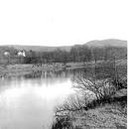Allegheny River
Introduction
Text-to-speech Audio
The campus of St. Bonaventure University backs right up to the Allegheny River. The campus and the Allegheny river interact in many ways, like a trail on campus that goes along the riverside. Did you know there has been two major floods of the Allegheny river that has impacted the town of Allegany and the St. Bonaventure University campus? These two floods occurred in 1942 and 1972. The Allegheny River has a rich history, especially with the surrounding areas.
Images
Early picture of Allegheny River

Backstory and Context
Text-to-speech Audio
For context, it is important to understand the geography of the river and the important history behind it. The river derives from northern Pennsylvania and flows about 325 miles northwest into New York. It then flows southwest back into Pennsylvania eventually connecting with the Monongahela River in Pittsburgh, PA to form the Ohio river. In order to understand the importance of the river, it is good to get a layout of where it flows to and what other major sources of water it connects with.
One may ask, "How did the river get its name?" The Allegheny river was discovered by the Delaware tribe, a form of the Algonquian people. This group of indigenous people had to move into western Pennsylvania when they were displaced by Iroquois. They named the river "welhik-heny". Welhik means "most beautiful" and Heny means "stream". It was eventually anglicized to be "Allegheny".
The river had played an important role throughout the town history. Whether its use with the lumber and rafting industries, or the way its flooding has impacted the town, this river will always be mentioned when regarding the large part of this town's history. In the other parts of this tour, you will learn about different parts of campus, and the town that were impacted by the floods of 1942 and 1972.
Sources
Allegany.org/allegheny-river-history.html
SBU Archives - Allegany section
SBU Archives
